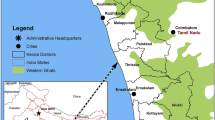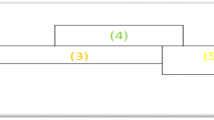Abstract
This study used spatial autoregression (SAR) model and geographically weighted regression (GWR) model to model the spatial patterns of farmland density and its temporal change in Gucheng County, Hubei Province, China in 1999 and 2009, and discussed the difference between global and local spatial autocorrelations in terms of spatial heterogeneity and non-stationarity. Results showed that strong spatial positive correlations existed in the spatial distributions of farmland density, its temporal change and the driving factors, and the coefficients of spatial autocorrelations decreased as the spatial lag distance increased. SAR models revealed the global spatial relations between dependent and independent variables, while the GWR model showed the spatially varying fitting degree and local weighting coefficients of driving factors and farmland indices (i.e., farmland density and temporal change). The GWR model has smooth process when constructing the farmland spatial model. The coefficients of GWR model can show the accurate influence degrees of different driving factors on the farmland at different geographical locations. The performance indices of GWR model showed that GWR model produced more accurate simulation results than other models at different times, and the improvement precision of GWR model was obvious. The global and local farmland models used in this study showed different characteristics in the spatial distributions of farmland indices at different scales, which may provide the theoretical basis for farmland protection from the influence of different driving factors.
Similar content being viewed by others
References
Anselin L, 1980. Estimation methods for spatial autoregressive structures. Journal of the American Statistical Association, 70(349): 120–126.
Bai Shuying, Zhang Shuwen, Zhang Yangzhen, 2007. Digital rebuilding of LUCC spatial-temporal distribution of the last 100 years: Taking Dorbod Mongolian Autonomous County in Daqing City as an example. Acta Geographica Sinica, 62(4): 427–436. (in Chinese)
Brunsdon C, Fotheringham A S, Charlton M E, 1996. Geographically weighted regression: A method for exploring spatial nonstationarity. Geographical Analysis, 28(4): 281–298. doi: 10.1111/j.1538-4632.1996.tb00936.x
Brunsdon C, Fotheringham A, Charlton M, 2002. Geographically weighted summary statistics—A framework for localised exploratory data analysis. Computers, Environment and Urban Systems, 26(6): 501–524. doi: 10.1016/S0198-9715(01)00009-6
Chen Youqi, Yang Peng, 2001. Recent progresses of international study on land use and land cover change. Economic Geography, 21(1): 95–100. (in Chinese)
Claessensa L, Schoorla J M, Verburga P H et al., 2009. Modelling interactions and feedback mechanisms between land use change and landscape processes. Agriculture, Ecosystems & Environment, 129(1–3): 157–170. doi: 10.1016/j.agee.2008.08.008
Erik L, Cheng D, 2008. Assessing farmland protection policy in China. Land Use Policy, 25(1): 59–68. doi: 10.1016/j.landusepol.2006.01.005
Fotheringham A S, Brunsdon C, Charlton M, 2002. Geographically Weighted Regression: The Analysis of Spatially Varying Relationships. Hoboken: John Wiley & Sons Inc.
Gao Zhiqiang, Yi Wei, 2012. Land use change in China and analysis of its driving forces using CLUE-S and Dinamica EGO model. Transactions of the Chinese Society of Agricultural Engineering (Transactions of the CSAE), 28(16): 208–216. (in Chinese)
Greene R P, 1997. The farmland conversion process in a polynucleated metropolis. Landscape and Urban Planning, 36(4): 291–300. doi: 10.1016/S0169-2046(96)00360-X
Guan D J, Gao W J, Wateri K, 2008. Land use change of Kitakyushu based on landscape ecology and Markov model. Journal of Geographical Sciences, 18(4): 455–468. doi: 10.1007/s11442-008-0455-0
Harris P, Fotheringham A S, Crespo R et al., 2011. The use of Geographically Weighted Regression for spatial prediction: An evaluation of models using simulated data sets. Math Geosciences, 43(6): 657–680. doi: 10.1007/s11004-011-9323-z
Huang C J, Tang Z Q, Zhou Q S et al., 2011. Application of improved error GM (1, 1) model on predicting of cultivated land in Yiyang. Energy Procedia, 5: 1172–1176. doi: 10.1016/j.egypro.2011.03.205
Hurvich C M, Simonoff J S, Tsai C L, 1998. Smoothing parameter selection in nonparametric regression using an improved Akaike information criterion. Journal of the Royal Statistical Society: Series B (Statistical Methodology), 60(2): 271–293. doi: 10.1111/1467-9868.00125
Jeffrey H D, Barry J B, John C B et al., 2008. Searching for farmland preservation markets: Evidence from the Southeastern U.S. Land Use Policy, 26(1): 121–129. doi: 10.1016/j.landusepol.2008.02.011
Jiang Qunóu, Deng Xiangzheng, Lin Yingzhi, 2010. Impacts of cultivated land conversion on cultivated land productivity in China: Prediction and analysis. Chinese Journal of Applied Ecology, 21(12): 3113–3119. (in Chinese)
Jun T, 2011. Spatially varying relationships between land use and water quality across an urbanization gradient explored by geographically weighted regression. Applied Geography, 31(1): 376–392. doi: 10.1016/j.apgeog.2010.08.001
Kulldorff M, 1998. Statistical methods for spatial epidemiology: Tests for randomness. In: Gatrell A and Løytønen M (eds). GIS and Health for Europe. London: Taylor & Francis, 49–62.
Lambin E, Rounsevell M, Geist H, 2000. Are agricultural land-use models able to predict changes in land-use intensity? Agriculture, Ecosystems & Environment, 82(1–3): 321–331. doi: 10.1016/S0167-8809(00)00235-8
Li X Y, Zhang S W, Wang Z M et al., 2004. Spatial variability and pattern analysis of soil properties in Dehui City of Jilin Province. Journal of Geographical Sciences, 14(4): 503–511.
Pijanowski B C, Brown D G, Shellito B A, 2002. Using neural networks and GIS to forecast land use changes: A land transformation model. Computers, Environment and Urban Systems, 26(6): 553–575. doi: 10.1016/S0198-9715(01)00015-1
Qiu Bingwen, Wang Qinmin, Chen Chongcheng, 2007. Spatial autocorrelation analysis of multi-scale land use in Fujian province. Journal of Natural Resources, 22(2): 311–321. (in Chinese)
Rutherford V P, 2011. Global and local analysis of fragmentation in a mountain region of Colorado. Agriculture, Ecosystems & Environment, 101(2–3): 207–218. doi: 10.1016/j.agee.2003.09.005
Su Y F, Foody G M, Cheng K S, 2012. Spatial non-stationarity in the relationships between land cover and surface temperature in an urban heat island and its impacts on thermally sensitive populations. Landscape and Urban Planning, 107(02): 172–180. doi: 10.1016/j.landurbplan.2012.05.016
Szymanowski M, Kryza M, 2011. Application of geographically weighted regression for modelling the spatial structure of urban heat island in the city of Wroclaw (SW Poland). Procedia Environmental Sciences, 3: 87–92. doi: 10.1016/j.proenv.2011.02.016
Tobler W R, 1970. A computer movie simulating urban growth in the Detroit region. Economic Geography, 46(4): 234–240
Wang Xiaoqin, Wang Qinmin, Li Huiguo, 2008. Spatial pattern of LUCC in different micro-geomorphic types of Huanghe River Delta. Scientia Geographica Sinica, 28(4): 513–517. (in Chinese)
Wang Y J, Cheng H, Edwards R L et al., 2001. A high-resolution absolute-dated late pleistocene monsoon record from Hulu Cave, China. Science, 294(5550): 2345–2348. doi: 10.1126/science.1064618
Xiangfan Statistical Bureau, 2000; 2010. Xiangfan Statistical Yearbook (1999; 2009). Beijing: China Statistics Press. (in Chinese)
Xie Hualin, Liu Liming, Li Bo, 2006. Spatial autocorrelation analysis of multi-scale land-use changes: A case study in Ongniud Banner, Inner Mongolia. Acta Geographica Sinica, 61(4): 389–400. (in Chinese)
Xu Jianbo, Song Lisheng, Xia Zhen et al., 2012. Spatial variability of available phosphorus for cultivated soil based on GARBF neural network. Transactions of the Chinese Society of Agricultural Engineering (Transactions of the CSAE), 28(16): 158–165. (in Chinese)
Zhu Likai, Meng Jijun, 2009. Advance in and tendencies of land use and cover change model. Progress in Geography, 28(5): 782–790. (in Chinese)
Author information
Authors and Affiliations
Corresponding author
Additional information
Foundation item: Under the auspices of National Natural Science Foundation of China (No. 40601073, 41101192, 41201571), Fundamental Research Funds for the Central Universities (No. 2011PY112, 2011QC041, 2011QC091), Huazhong Agricultural University Scientific & Technological Self-innovation Foundation (No. 2011SC21)
Rights and permissions
About this article
Cite this article
Zhang, H., Guo, L., Chen, J. et al. Modeling of spatial distributions of farmland density and its temporal change using geographically weighted regression model. Chin. Geogr. Sci. 24, 191–204 (2014). https://doi.org/10.1007/s11769-013-0631-8
Received:
Accepted:
Published:
Issue Date:
DOI: https://doi.org/10.1007/s11769-013-0631-8




